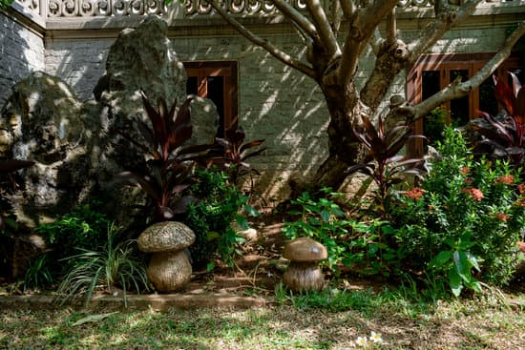In recent years, the shift toward sustainable living has gained immense popularity, driven by an increasing awareness of environmental issues.(Nature materials)

One area where this consciousness is particularly evident is in home decor. Sustainable and eco-friendly decor not only promotes environmental responsibility but also creates a healthier living space.(Nature materials) This article explores various aspects of sustainable decor, including materials, design principles, and practical tips for transforming your home into a green sanctuary. (Nature materials)
Understanding Sustainable Decor.
Sustainable decor refers to the use of materials and practices that minimize environmental impact. This can include the sourcing of natural materials, repurposing existing items, and incorporating energy-efficient technologies. The goal is to create a space that is both aesthetically pleasing and environmentally responsible.
Benefits of Sustainable Decor.
1. Environmental Impact: Reducing waste and minimizing the carbon footprint contribute to a healthier planet.
2. Healthier Living Space: Eco-friendly materials often contain fewer toxic substances, improving indoor air quality.
3. Cost Savings: Investing in sustainable products can lead to long-term savings through durability and energy efficiency.
4. Unique Aesthetic: Sustainable decor often embraces natural beauty, resulting in unique and creative designs.

Choosing Eco-Friendly Nature Materials.
Natural Fibers:Opt for textiles made from natural fibers such as organic cotton, hemp, jute, and linen. These materials are biodegradable and often produced without harmful pesticides and chemicals.
Reclaimed Wood:Reclaimed wood adds character and warmth to a space. Sourced from old buildings or furniture, it reduces the demand for new timber and helps preserve forests. Plus, each piece tells a story, making your decor unique.
Bamboo:Bamboo is one of the fastest-growing plants on Earth, making it a highly renewable resource. It’s durable, versatile, and can be used for furniture, flooring, and decorative items.
Recycled Materials:Furniture and decor items made from recycled materials—such as glass, metal, and plastic—help divert waste from landfills. Look for products made from post-consumer waste to ensure a smaller ecological footprint.
Low-VOC Paints and Finishes:Volatile Organic Compounds (VOCs) are chemicals found in many paints and finishes that can harm indoor air quality. Choosing low-VOC or VOC-free options not only enhances your health but also contributes to a more sustainable environment.(Nature materials )
Incorporating Sustainable Design Principles. (Nature materials)
Minimalism:Adopting a minimalist approach reduces clutter and emphasizes quality over quantity. This means investing in fewer, higher-quality pieces that have a timeless appeal, ultimately leading to less waste.
Multi-Functional Furniture: Choose furniture that serves multiple purposes. For instance, a coffee table with storage or a sofa bed maximizes space and reduces the need for additional pieces, making your home more efficient and eco-friendly.

Biophilic Design:Incorporate natural elements into your decor. This can be achieved through indoor plants, natural light, and organic shapes. Biophilic design connects occupants with nature, promoting well-being and a sense of peace.
Energy Efficiency:Consider energy-efficient lighting and appliances. LED bulbs use significantly less energy than traditional incandescent bulbs, while ENERGY STAR-rated appliances reduce energy consumption and lower utility bills.
Local Sourcing:Support local artisans and businesses by sourcing decor items from nearby suppliers. This not only reduces transportation emissions but also contributes to the local economy.
Practical Tips for Eco-Friendly Decor.
Upcycle and Repurpose:Before discarding old furniture or decor items, consider ways to upcycle them. A coat of paint can breathe new life into an old dresser, while vintage frames can be repurposed for art displays.
Shop Secondhand.
Thrift stores, consignment shops, and online marketplaces are treasure troves for sustainable decor. Shopping secondhand extends the life of products and reduces the demand for new items.
DIY Projects:Engage in DIY projects to create personalized decor. Whether it’s making your own art, building furniture, or sewing throw pillows, DIY projects allow you to control the materials and processes involved.
Use Plants for Decoration:Incorporate houseplants into your decor. Not only do they improve air quality, but they also add a touch of nature to your space. Opt for low-maintenance varieties if you’re new to indoor gardening.
Choose Timeless Designs:Invest in classic designs that won’t go out of style. Timeless decor pieces can last for years, reducing the need for frequent replacements and minimizing waste.
Mindful Purchases:Before making a purchase, consider the item’s lifecycle. Ask yourself if it’s necessary, how long it will last, and whether it can be recycled or repurposed at the end of its life.
Conclusion.
Creating a sustainable and eco-friendly home is not only beneficial for the environment but also enhances your well-being and quality of life. By choosing natural, recycled, and local materials, adopting sustainable design principles, and incorporating practical tips, you can transform your living space into a green sanctuary.(Nature materials)
The journey toward sustainable decor is an ongoing process, but with each mindful choice, you contribute to a healthier planet and a more beautiful home. Embrace this challenge, and enjoy the satisfaction that comes from creating a space that reflects your values and respects the earth.Nature materials.

